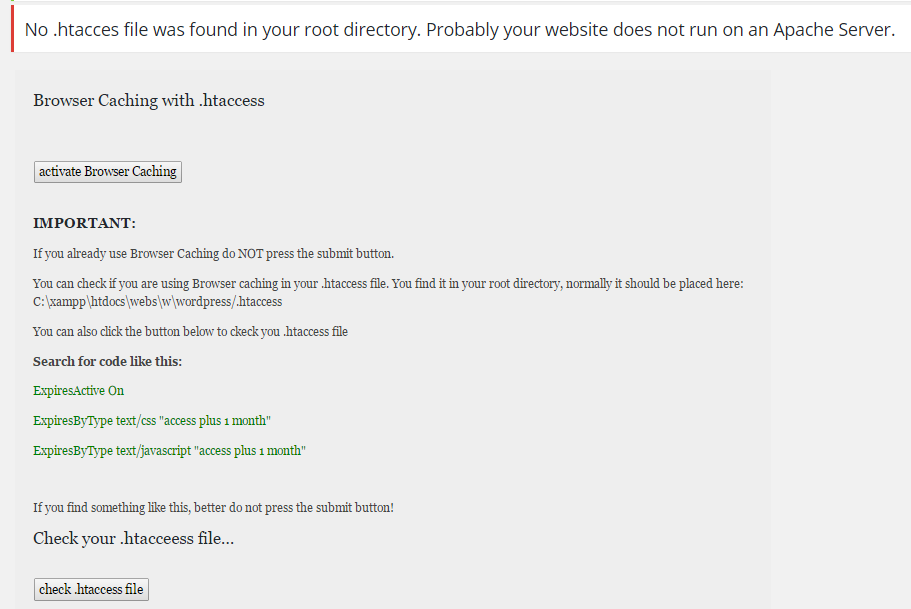
Browser Caching with .htaccess Plugin
Speed up your website with Browser Caching. This Plugin enables Browser Caching in your Apache Web Server, which will make your website faster.
With Browser Caching you can tell Browsers when your files usually change, e.g. every month, every week, etc. This will fasten up your website because Browser will only make requests to your Server after the declared time. PageSpeed is a Google Ranking Factor so it is important to have a fast website.
There a several ways to enable Browser Caching. This Plugin uses Expires. The following code will be added to your .htaccess file:
ExpiresActive On
ExpiresByType text/css “access plus 1 month”
ExpiresByType text/javascript “access plus 1 month”
ExpiresByType text/html “access plus 1 month”
ExpiresByType application/javascript “access plus 1 month”
ExpiresByType application/x-javascript “access plus 1 month”
ExpiresByType application/xhtml-xml “access plus 1 month”
ExpiresByType image/gif “access plus 1 month”
ExpiresByType image/jpeg “access plus 1 month”
ExpiresByType image/png “access plus 1 month”
ExpiresByType image/x-icon “access plus 1 month”
The second line means that css files will be requested after 1 month. The third line means that javascript files will be requested after 1 month and so on.
Of course you can change the periods. You will find instructions for that in the FAQ section.
In case you do not have reading rights to the .htaccess file you will get a 403 Permission Denied Error Page. So before activating this Plugin make sure you have reading rights to the .htaccess file (normally you have those rights).
Installation
- Upload the plugin directory ‘ browser_caching_htaccess’ to the ‘/wp-content/plugins/’ directory.
- Activate the plugin through the ‘Plugins’ menu in WordPress.
- Go to ‘Tools’ in the Dashboard Sidebarand look for ‘Browser Caching’.
- Read the instructions on the Plugin Dahboard.
- Check if your website has a .htaccess file. You can either do this by pressing the button ‘check .htaccess file’ or look directly in your ‘root’ directory. Make sure the file is writable.
- Also check if you are already using Browser Caching with ‘Expires’. Therefore search for the code shown above in your .htaccess file.
- If you are not already using Browser Caching with Expires press the ‘activate Browser Caching’ button and the code will get added to your .htaccess file.
- DONE!
Screenshots

The Plugin Dashboard

The impact of a sample .htaccess file, shown after the 'check .htaccess file' button was clicked

Error message after 'activate Browser Caching' button was clicked and no .htaccess file was found

Success message after Browser Caching was successfully activated

To open the modification menu press the 'modify Expires' button

Error message that occurs when you are already using Browser Caching
FAQ
Installation Instructions
- Upload the plugin directory ‘ browser_caching_htaccess’ to the ‘/wp-content/plugins/’ directory.
- Activate the plugin through the ‘Plugins’ menu in WordPress.
- Go to ‘Tools’ in the Dashboard Sidebarand look for ‘Browser Caching’.
- Read the instructions on the Plugin Dahboard.
- Check if your website has a .htaccess file. You can either do this by pressing the button ‘check .htaccess file’ or look directly in your ‘root’ directory. Make sure the file is writable.
- Also check if you are already using Browser Caching with ‘Expires’. Therefore search for the code shown above in your .htaccess file.
- If you are not already using Browser Caching with Expires press the ‘activate Browser Caching’ button and the code will get added to your .htaccess file.
- DONE!
Can I change the periods of the Caching?
Yes, to change the periods go the Plugin’s directory, usually found at ‘wp-content/plugins/browser_caching_htaccess/’. Open the file ‘caching.php’ and go to line 21. The defined periods of the Expires are from line 21 to line 30. You can change them there.
Can I change the periods of the caching without editing the code?
Since version 1.1 there is a modification menu on the plugin dashboard. Go to the admin dashboard and click the ‘modify Expires’ button to open the menu.
Can I change the periods of the caching after I already activated the caching?
If you already activated the caching you can not change the periods via the plugin dashboard. First you have to delete the inserted block in you .htaccess file, after that you can change the periods.
When you want to delet the inserte block for changing the periods, you can also change them directly when opening the file on your server.
Can I use Browser Caching without .htaccess file?
To enable Browser Caching this Plugin adds code to your .htaccess file. Therefore this file is necessary for this Plugin.
What do I do when my .htaccess is not writable?
When it is not writable the Plugin can not add code. You have to change the file permissons to e.g. 644.
What happens when I activate Browser Caching even if I already use it in the .htaccess?
Since Version 1.2 this is no longer possible. If youre Apache Server is already configured to use Browser Caching with Expires it is no longer possible to activate Browser Caching again via this plugin.